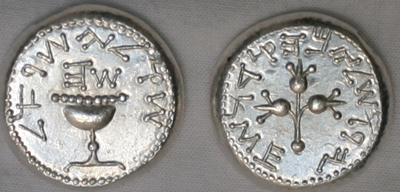First Revolt Shekel and Half Shekel
The original Shekels and Half Shekels that our reproductions are based on, were minted during the last five years of the First Holy Temple (65-70 CE).

Obverse (front)
On the obverse (front) of the coin is a cup. Many numismatists suggest that it is a depiction of a cup used to collect the Omer barley (Vayikra (Leviticus) 23:10). On the shekel it says in ancient Hebrew letters: Shekel Yisroel (Shekel of Israel). On the half shekel it says Chatzi Hashekel (half of a shekel). Over the cup is the date. The half shekel says shin beit which stands for shana beit (year two). This corresponds to 66-67 c.e. or 3827 a.m. The shekel says shin hay which stands for shana hey (year five) which was the last year that the Beit HaMikdash (Holy Temple) was standing. This corresponds to the year 70 c.e. or 3830 a.m.
Reverse (back)
On the reverse, there are three pomegranates, one of the special fruits of the Land of Israel (Devarim – Deuteronomy 8:8). It says in ancient Hebrew script: Yerushalayim Hakedoshah (Jerusalem the Holy).
These museum quality hand minted reproductions contain one half ounce and one quarter ounce respectively of .999 silver.
Originals of these coins sell for thousands of dollars.
Bar Kochva Shekel (also called Sela)
The original Shekel of Bar Kochva was minted in the years 131-135 CE. These museum quality hand minted reproductions contain one half ounce of .999 silver.
Obverse
On the obverse (front) is a depiction of the Holy Temple. Above the Temple is a star which may be a symbol for Bar Kochva which means son of the star. Around the sides of the Temple, in ancient Hebrew letters it says Shim`on (Bar Kochva’s first name).
Reverse
On the reverse (back) is a depiction of a lulav and ethrog (palm branch and citron, used on the Festival of Sukkoth (Feast of Booths) (Vayikra – Levitcus 23:40). The inscription, in ancient Hebrew letters, says For the Freedom of Israel.
These museum quality hand minted reproductions contain one half ounce of .999 silver.

The first obverse is a bunch of grapes (one of the fruits for which the Land of Israel is praised in the Bible (Devarim – Deuteronomy 8:8).

The second obverse is a wreath. It is suggested that the wreath is either olive leaves (one of the fruits for which the Land of Israel is praised in the Bible, or myrtle branches, one of the four plants used in the Sukkoth (Feast of Booths) ritual (Vayikra – Levitcus 23:40).

Narrow Lyre or Harp (sometimes referred to as Kithara) and in Hebrew as Kinnor.

Wide Lyre or Harp called Nevel in Hebrew.

Palm Branch one of the four plants used in the Sukkoth (Feast of Booths) ritual (Vayikra – Levitcus 23:40).

Pitcher together with Palm Branches. Probably the Pitcher is the kind used to pour the wine offerings on the Mizbe’ach (Altar).

Trumpets called Hatzotzeroth in Hebrew. The Trumpets were used to call marching orders in the desert wanderings and in time of war, and were also used in the Temple Services. (Bamidbar – Numbers 10:8).
Each of our museum quality, hand minted zuzim contains one eighth ounce of .999 silver.
So far, we have produced four of the zuzim types, both obverses with the palm branch reverse and with the pitcher and palm branch reverse.
To learn more about how we reproduced the coins see Creating Judaic Coins: the Process.
Each of our museum quality, hand minted zuzim contains one eighth ounce of .999 silver.
So far, we have produced four of the zuzim types, both obverses with the palm branch reverse and with the pitcher and palm branch reverse.
To learn more about how we reproduced the coins see Creating Judaic Coins: the Process.
To purchase these coins individually or as a set, visit the Coins page.